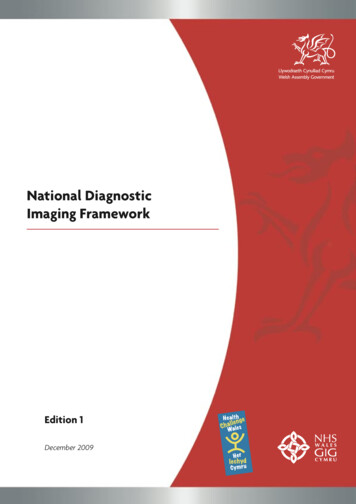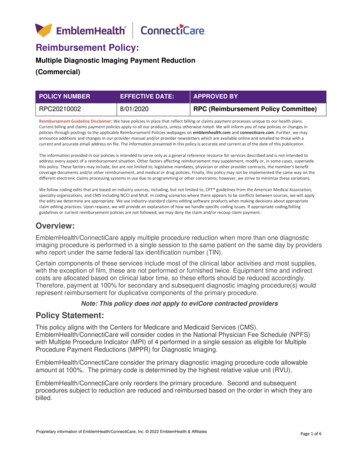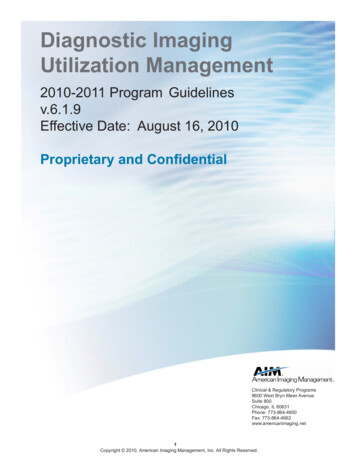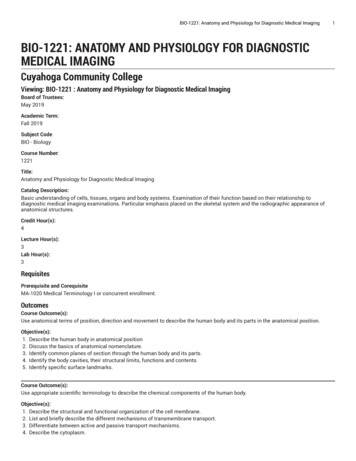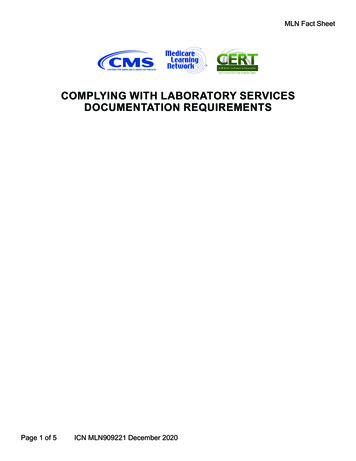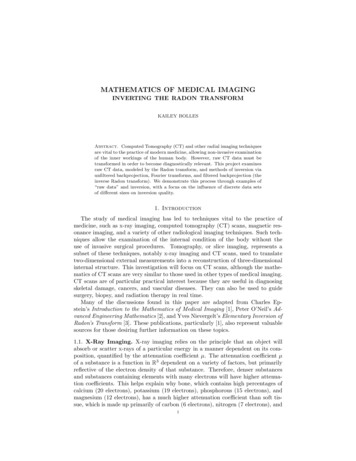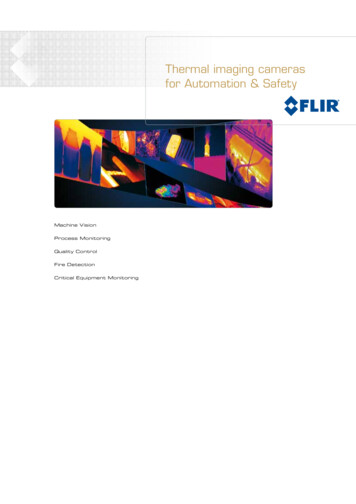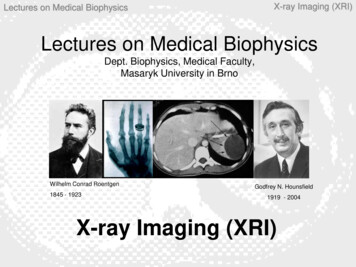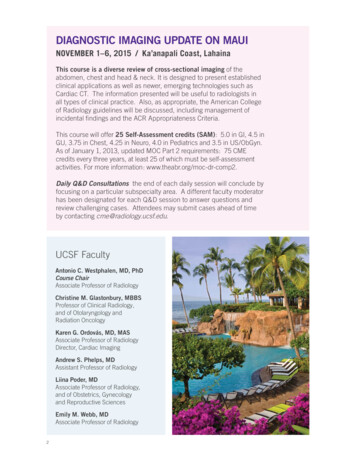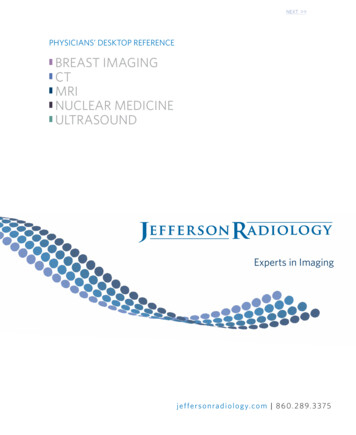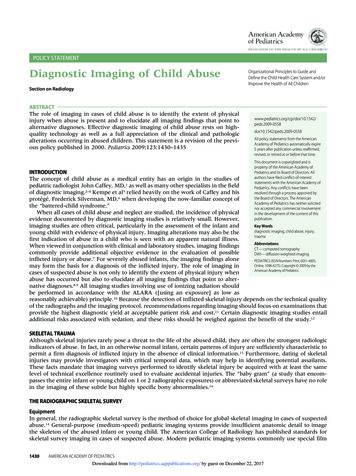
Transcription
POLICY STATEMENTDiagnostic Imaging of Child AbuseOrganizational Principles to Guide andDefine the Child Health Care System and/orImprove the Health of All ChildrenSection on RadiologyABSTRACTThe role of imaging in cases of child abuse is to identify the extent of physicalinjury when abuse is present and to elucidate all imaging findings that point toalternative diagnoses. Effective diagnostic imaging of child abuse rests on highquality technology as well as a full appreciation of the clinical and pathologicalterations occurring in abused children. This statement is a revision of the previous policy published in 2000. Pediatrics 1542/peds.2009-0558doi:10.1542/peds.2009-0558All policy statements from the AmericanAcademy of Pediatrics automatically expire5 years after publication unless reaffirmed,revised, or retired at or before that time.This document is copyrighted and isproperty of the American Academy ofPediatrics and its Board of Directors. Allauthors have filed conflict-of-intereststatements with the American Academy ofPediatrics. Any conflicts have beenresolved through a process approved bythe Board of Directors. The AmericanAcademy of Pediatrics has neither solicitednor accepted any commercial involvementin the development of the content of thispublication.INTRODUCTIONThe concept of child abuse as a medical entity has an origin in the studies ofpediatric radiologist John Caffey, MD,1 as well as many other specialists in the fieldof diagnostic imaging.2–4 Kempe et al5 relied heavily on the work of Caffey and hisprotégé, Frederick Silverman, MD,6 when developing the now-familiar concept ofthe “battered-child syndrome.”When all cases of child abuse and neglect are studied, the incidence of physicalevidence documented by diagnostic imaging studies is relatively small. However,imaging studies are often critical, particularly in the assessment of the infant andKey Wordsdiagnostic imaging, child abuse, injury,young child with evidence of physical injury. Imaging alterations may also be thetraumafirst indication of abuse in a child who is seen with an apparent natural illness.AbbreviationsWhen viewed in conjunction with clinical and laboratory studies, imaging findingsCT— computed tomographycommonly provide additional objective evidence in the evaluation of possibleDWI— diffusion-weighted imaginginflicted injury or abuse.7 For severely abused infants, the imaging findings alonePEDIATRICS (ISSN Numbers: Print, 0031-4005;Online, 1098-4275). Copyright 2009 by themay form the basis for a diagnosis of the inflicted injury. The role of imaging inAmerican Academy of Pediatricscases of suspected abuse is not only to identify the extent of physical injury whenabuse has occurred but also to elucidate all imaging findings that point to alternative diagnoses.8,9 All imaging studies involving use of ionizing radiation shouldbe performed in accordance with the ALARA ([using an exposure] as low asreasonably achievable) principle.10 Because the detection of inflicted skeletal injury depends on the technical qualityof the radiographs and the imaging protocol, recommendations regarding imaging should focus on examinations thatprovide the highest diagnostic yield at acceptable patient risk and cost.11 Certain diagnostic imaging studies entailadditional risks associated with sedation, and these risks should be weighed against the benefit of the study.12SKELETAL TRAUMAAlthough skeletal injuries rarely pose a threat to the life of the abused child, they are often the strongest radiologicindicators of abuse. In fact, in an otherwise normal infant, certain patterns of injury are sufficiently characteristic topermit a firm diagnosis of inflicted injury in the absence of clinical information.13 Furthermore, dating of skeletalinjuries may provide investigators with critical temporal data, which may help in identifying potential assailants.These facts mandate that imaging surveys performed to identify skeletal injury be acquired with at least the samelevel of technical excellence routinely used to evaluate accidental injuries. The “baby gram” (a study that encompasses the entire infant or young child on 1 or 2 radiographic exposures) or abbreviated skeletal surveys have no rolein the imaging of these subtle but highly specific bony abnormalities.14THE RADIOGRAPHIC SKELETAL SURVEYEquipmentIn general, the radiographic skeletal survey is the method of choice for global skeletal imaging in cases of suspectedabuse.14 General-purpose (medium-speed) pediatric imaging systems provide insufficient anatomic detail to imagethe skeleton of the abused infant or young child. The American College of Radiology has published standards forskeletal survey imaging in cases of suspected abuse. Modern pediatric imaging systems commonly use special film1430AMERICAN ACADEMY OF PEDIATRICSDownloaded from http://pediatrics.aappublications.org/ by guest on December 22, 2017
cassettes and intensifying screens to minimize exposure.Although these low-dose systems are adequate for chestand abdominal imaging, they fail to provide the necessary detail (contrast and spatial resolution) to imagesubtle metaphyseal, rib, and other high-specificity injuries that are characteristic of abuse. According to theAmerican College of Radiology, high-detail imaging systems should be used for suspected abuse in infancy.14These systems should be used without an antiscattergrid. Beyond infancy, faster general-purpose systems arerequired for thicker body regions (eg, skull, lateral lumbar spine).Digital or filmless radiography has replaced screen/film imaging in most pediatric health care facilities in theUnited States.15 A wide array of digital systems are available, including direct and indirect technologies. Datasuggest that despite its lower spatial resolution, digitalradiography, with its wide dynamic range and high contrast capabilities, can provide diagnostic performancecomparable to high-detail screen/film systems in theevaluation of skeletal injury.16,17 High-detail digital systems are being used successfully in the rigorous field ofmammography, and efforts are currently underway toapply similar techniques to demanding skeletal applications.18 Unfortunately, most digital systems currentlyused for skeletal surveys in the United States operate atrelatively low spatial resolutions, and they are not routinely optimized for the demanding practice of imagingfor suspected child abuse.15 Imaging departments shoulduse digital systems with sufficient spatial resolution andsignal-to-noise characteristics to detect subtle skeletalinjuries. Image detail and diagnostic performance can beimproved by optimizing exposure to diminish systemnoise. Acceptable diagnostic accuracy with traditionalscreen/film imaging has required higher radiation exposures than for routine pediatric radiography, and similarly, an increase in exposure over standard digital radiography can be expected if maximal diagnostic accuracyis to be preserved with the digital medium. However,recent data have suggested that a performance comparable to the high-detail screen/film gold standard may beachievable with high-detail digital imaging at a substantially lower patient dose.17 Digital facilities should optimize their acquisition and display parameters for highdiagnostic performance,19 and if the resultant imagesprovide insufficient bony detail, an acceptable alternative should be sought. A radiologist should monitor theskeletal survey to ensure that appropriate high-qualityimages are obtained and to determine if additional viewsare required to fully define the pathologic alterations.Imaging ProtocolOnce the appropriate imaging system is chosen, a preciseprotocol for skeletal imaging must be developed to ensure consistent quality. In routine skeletal imaging, anaccepted principle is that film must be coned or restrictedto the specific anatomic area of interest. It is commonpractice to encompass larger anatomic regions whenskeletal surveys are performed, which results in areas ofunderexposure and overexposure as well as loss of resolution resulting from geometric distortion and otherTABLE 1 Complete Skeletal Survey Table14Appendicular skeletonArms (AP)Forearms (AP)Hands (PA)Thighs (AP)Legs (AP)Feet (PA or AP)Axial skeletonThorax (AP and lateral), to include thoracic spine and ribsAP abdomen, lumbosacral spine, and bony pelvisLumbar spine (lateral)Cervical spine (AP and lateral)Skull (frontal and lateral)AP indicates anteroposterior; PA, posteroanterior.technical factors. The standard skeletal survey imagingprotocol that has been developed by the American College of Radiology14 is provided in Table 1. Of special noteis the inclusion of lateral views of the spine to assess forvertebral fractures and dislocations and separate views ofthe hands and feet to identify subtle digital injuries.Anteroposterior and lateral views of the skull are mandatory even when cranial computed tomography (CT)has been performed, because skull fractures coursing inthe axial plane may be missed with axial CT.11 A full4-view examination of the skull (right and left lateral,Townes, and anteroposterior) should be obtained whenhead injury is present. Skeletal injuries, especially thoserequiring orthopedic management, necessitate at least 2radiographic projections. Oblique views of the thoraxincrease the yield for the detection of rib fractures.20 At aminimum, right and left oblique views of the thoraxshould be obtained when rib fractures are evident, andconsideration should be given to including obliques inthe standard survey protocol. A follow-up skeletal survey approximately 2 weeks after the initial study increases the diagnostic yield21,22 and should be performedwhen abnormal or equivocal findings are found on theinitial study and when abuse is suspected on clinicalgrounds. A repeat study may permit more precise determination of the age of individual injuries. Lack of interval change may indicate that the initial radiographicfinding is a normal anatomic variant or is related to abone dysplasia. Views of the skull can be omitted fromthe follow-up study.Radionuclide Bone ScansWhen performed by staff experienced with pediatric nuclear imaging, skeletal scintigraphy may offer an alternative or adjunct to the radiographic skeletal survey inselected cases, particularly for children older than 1 year.Scintigraphy can provide increased sensitivity for detecting rib fractures, subtle shaft fractures, and areas of earlyperiosteal elevation. However, scintigraphy is less sensitive than radiography for detection of classic metaphyseal lesions, which are fractures that carry a high specificity for abuse in infants.23–25 Skeletal scintigraphyusually requires sedation and is generally more expensive than radiographic surveys. Bone scans are used toPEDIATRICS Volume 123, Number 5, May 2009Downloaded from http://pediatrics.aappublications.org/ by guest on December 22, 20171431
supplement radiographic skeletal surveys in the acutecare setting,24 but for the child who is placed in a “safe”environment, a follow-up skeletal survey is an attractivealternative to initial scintigraphy. If radionuclide bonescans are performed as the initial study, all positive areasmust be evaluated further with radiography. Becausescintigraphy is insensitive for detecting cranial injuries,skull radiography in at least 2 projections must supplement the bone scan.Imaging GuidelinesThe skeletal survey is mandatory in all cases of suspectedphysical abuse in children younger than 2 years; itsutility diminishes thereafter.8,26 The screening skeletalsurvey or bone scan has little value in children olderthan 5 years. Decisions about which types of imaging toperform for patients in the 2- to 5-year-old age groupmust be made individually on the basis of the specificclinical indicators of abuse. At any age, when clinicalfindings point to a specific site of injury, the customaryradiographic protocol for imaging that anatomic regionshould be used. MRI and ultrasonography may be indicated when epiphyseal separations are suspected on thebasis of plain-film radiography.2,27 Evidence suggests thatif 1 infant twin is injured, the other is at risk and shouldalso undergo a skeletal survey.28 Although there seemsto be an association between physical and sexual abuse,the prevalence of fractures in sexually assaulted childrenis low; thus, skeletal surveys should be performed onlyin selected cases on the basis of specific clinical indications.29,30 Although the high-quality skeletal survey isessential in the evaluation of suspected physical abuse ininfants and toddlers, it may not be available in the emergency department setting during evening hours.15 TheAmerican Academy of Pediatrics has stated that hospitalization of the abused child may be medically necessaryfor diagnosis,31 and in some instances it may be advisableto place a child in a safe haven until a proper skeletalsurvey can be performed.31 A skeletal survey may bedifficult to obtain in a critically injured child on lifesupport. Efforts should be directed at performing anadequate examination in a timely manner, because theresults may have an effect on the early investigation ofthe case.HEAD TRAUMAHigh-energy forces associated with impact or violentshaking result in a variety of central nervous systeminjuries that can be detected by modern neuroimagingtechniques. The evolution of these injuries, as well asprocesses that develop secondary to the original insult,are often effectively displayed on serial imaging studies.2,32–35All infants and children with suspected intracranialinjury must undergo cranial CT, MRI, or both. Strategiesshould be directed toward the detection of all intracranial sequelae of abuse and neglect with a thoroughcharacterization of the extent and age of the abnormalities.36 In the acute-care setting, efforts are directed toward rapid detection of treatable conditions. Subsequent1432studies are designed to more fully delineate all abnormalities, determine the timing of the injuries, and monitor their evolution.Computed TomographyCT without intravenous contrast should be performed aspart of the initial evaluation for suspected acute inflictedhead injury. CT has high sensitivity and specificity fordiagnosing acute intraparenchymal, subarachnoid, subdural, and epidural hemorrhage. Abnormalities that require emergency surgical intervention generally are welldemonstrated. CT is readily available and rapidly performed for critically ill patients and is generally betterthan MRI for evaluation of acute hemorrhage. Skullfractures, associated soft tissue swelling, and facial fractures also can be diagnosed on CT images with appropriate bone window and level settings. With modernmultidetector CT scanners, the brain can be imaged in afew seconds, usually obviating the need for sedation.UltrasonographyUltrasonography via the anterior fontanelle in younginfants has gained an important role in clarifying thenature of extra-axial fluid collections in infancy. Becauseultrasonography reliably differentiates convexity subdural from subarachnoid collections, it is particularlyuseful for the infant with macrocephaly or any infantwith large hypodense cerebral convexity collectionsdemonstrated by CT.37 Subcortical white matter tears inthe frontal and anterior parietal parasagittal regions canbe demonstrated with ultrasonography.38 These lesionsare less well defined by axial CT, and ultrasonographyprovides the advantage of a bedside technique. Becauseultrasonography is insensitive for detecting small acutesubdural hematomas, particularly within the interhemispheric fissure, and many other acute intracranial injuries, it must be performed in conjunction with CT or MRIwhen traumatic injury is suspected.29,39Magnetic Resonance ImagingAlthough cranial MRI has some limitations in the acutecare setting, it remains the best modality for fully assessing intracranial injury, including extra-axial collections,intraparenchymal hemorrhages, contusions, shear injuries, and brain swelling or edema. A strong argumentcan be made for MRI in all cases with positive cranial CTfindings and in selected cases with normal CT results butstrong clinical concerns. MRI should be performed withT1 and T2 weighting with proton-density or inversionrecovery sequences to differentiate cerebrospinal fluidcollections from other water-containing lesions. Gradient echo sequences should be included to detect hemorrhage or mineralization not demonstrable by otherMRI techniques. Although the specific type and order ofpulse sequences may vary, imaging must be performedat least in the axial and coronal planes. Acute subarachnoid and subdural hemorrhage may be inconspicuouson MRI, and consideration should be given to delayingthe examination for 5 to 7 days, permitting subacuteAMERICAN ACADEMY OF PEDIATRICSDownloaded from http://pediatrics.aappublications.org/ by guest on December 22, 2017
blood to become hyperintense on T1-weighted sequences.Diffusion-weighted imaging (DWI) is a relatively newand valuable technique for the evaluation of stroke andis gaining a role in the assessment of inflicted cerebralinjury. When performed early in the critically injuredinfant, DWI may provide information regarding cerebralinjury before parenchymal abnormalities are visible onCT or conventional MRI sequences.40,41 The value of thepotential findings revealed with DWI must be weighedagainst the lower sensitivity of MRI in the detection ofacute extra-axial blood collections and the practicalproblems encountered when performing MRI in severely ill infants.Abused infants may not demonstrate neurologic signsand symptoms despite significant central nervous systeminjury.2,42,43 MRI offers the highest sensitivity and specificity for diagnosing subacute and chronic injury andshould be considered whenever typical skeletal injuriesassociated with shaking or impact are identified.39,44SPINAL TRAUMAPlain radiographs are often sufficient to evaluate vertebral compression and spinous process fractures. Complex fractures may require helical CT with multiplanarreformatted images. If a fracture or subluxation maycompromise the spinal contents or if clinical findingsindicate spinal cord or nerve root injury, MRI should beperformed. Increasing attention has been directed toward a possible association of cervical spinal cord injuryand extra-axial hemorrhage with inflicted head injury,and some centers include the cervical region in theircranial MRI trauma protocols.45,46THORACOABDOMINAL TRAUMABlunt thoracoabdominal injury may occur in victims ofchild abuse. The evaluation and management of acutethoracoabdominal injury is the same as for children withaccidental injuries.47 However, when an infant or childsustains serious injury to the chest or abdomen withouta known or observed mechanism or when the imagingfindings are inconsistent with the purported history,investigation of potential child abuse is warranted. Failure to recognize inflicted blunt abdominal trauma contributes to higher morbidity and mortality rates thanthose seen with accidental abdominal injury.48 Pancreatitis, duodenal hematomas, bowel perforation, and thoracoabdominal injury associated with rib fractureheighten the suspicion of child abuse. Chest, abdominal,and cervical spine radiographs often are obtained in theinitial assessment of injured children. If internal chest orabdominal injury is suspected and the patient’s condition is stable, a CT scan should be performed. A CT scanwill best demonstrate many of the injuries associatedwith child abuse. The chest should be included if seriouschest trauma is suspected.The use of oral contrast is debatable. Oral contrastin the stomach and small bowel is useful to better definethe lesser sac of the peritoneum, pancreas, duodenum,and jejunum. However, oral contrast may place the pa-TABLE 2 Imaging Recommendations for ThoracoabdominalTrauma1.2.3.Helical CTa of abdomen and/or thorax with intravenous contrast;nonionic is preferable; gastrointestinal contrast optionalUltrasonography of abdomen, usually as a follow-up examinationUpper-gastrointestinal seriesa Relative contraindication: strong history of allergy to iodine, severe shock, and renalfailure.tient at greater risk of aspirating, especially if the patientis obtunded, sedated, or immobilized. If surgery or general anesthesia is likely, it is better to have an emptystomach.Intravenous contrast is used routinely. Vascular injuries and injuries to the liver, spleen, pancreas, and kidneys are best demonstrated after administration of intravenous contrast material. Helical scanning with propertiming of the intravenous contrast bolus is important foraccurate diagnosis. Given the heightened awareness ofcancer risks associated with CT scanning in childhood,care should be taken to adjust technical factors toachieve diagnostic quality images at an exposure as lowas reasonably achievable.49,50 The only relative contraindications for intravenous contrast are a strong history ofallergy to iodine, severe shock, and renal failure.Abused children suffer some of the same injuries aschildren with accidental blunt trauma. In the chest, pulmonary contusion, pneumothorax, pleural effusion, ribfractures, and vascular or tracheobronchial injuries mayoccur. Abused children have an increased occurrence ofpancreatic injuries and duodenal hematomas. Bowel injury should be suspected when there is peritoneal fluidwithout evidence of solid organ injury and assumedwhen free intraperitoneal air or extraluminal contrast isobserved.51 Bone windows should be monitored notonly for rib fractures but also for signs of pelvic or spinefractures.Peritoneal lavage rarely is used in pediatric practice. Ifperformed before CT, it may decrease the diagnosticusefulness. Peritoneal lavage sometimes is used whenemergency surgery is required to treat a patient whosecondition is not stable enough for a CT scan.49The use of ultrasonography in pediatric trauma iscontroversial. Some institutions have used ultrasonography successfully for a more detailed, comprehensiveevaluation of organ injury. However, for seriously injured children and those with suspected child abuse, CTscanning is the preferred initial diagnostic modality inmost institutions. Peritoneal fluid alone, which can bedetected well with both ultrasonography and CT scanning, is a poor predictor of major trauma in children. Anupper-gastrointestinal series sometimes is used to evaluate and follow-up duodenal hematomas.Nonoperative management of injury to the liver,spleen, kidney, or pancreas is common in most pediatriccenters. Follow-up imaging usually is limited but may beuseful to help determine recommendations for the levelof physical activity (Table 2).PEDIATRICS Volume 123, Number 5, May 2009Downloaded from http://pediatrics.aappublications.org/ by guest on December 22, 20171433
CONCLUSIONSThe diagnostic imaging of suspected inflicted injury ininfancy and childhood should be performed with at leastthe same rigor used in the imaging evaluation of accidental trauma and naturally occurring disease. To beconfident that the imaging studies are acquired and interpreted in a thorough and informed manner, clinicianscharged with reporting and providing evidence in casesof suspected abuse should work in close collaborationwith radiologists experienced in pediatric imaging. Thisapproach will help ensure that child abuse is accuratelyidentified and reliably differentiated from conditionsthat may simulate abuse.14SECTION ON RADIOLOGY, 2006 –2007Michael A. Di Pietro, MD, ChairpersonAlan S. Brody, MDChristopher I. Cassady, MDPaul K. Kleinman, MD*John B. Wyly, MDKimberly E. Applegate, MDBeverly P. Wood, MDJeffrey M. Zerin, MDMaria G. Mercado-Deane, MDJoanna J. Seibert, MDSTAFFAleksandra Stolic, MPH*Lead authorsREFERENCES1. Reece RM, Ludwig S, eds. Child Abuse: Medical Diagnosis andManagement. Philadelphia, PA: Lippincott Williams & Wilkins;20012. Kleinman PK. Diagnostic Imaging of Child Abuse. St Louis, MO:Mosby; 19983. Kuhn JP, Slovis TL, Haller JO. Caffey’s Pediatric Diagnostic Imaging. Philadelphia, PA: Mosby; 20044. Caffey J. Multiple fractures in the long bones of infants suffering from chronic subdural hematoma. AJR Am J Roentgenol.1946;56(2):163–1735. Kempe CH, Silverman FN, Steele BF, Droegemueller W, SilverHK. The battered-child syndrome. JAMA. 1962;181(Jul 7):17–246. Silverman F. The roentgen manifestations of unrecognizedskeletal trauma in infants. Am J Roentgenol. 1953;69(3):413– 4277. Kleinman PK, Blackbourne BD, Marks SC, Karellas A, BelangerPL. Radiologic contributions to the investigation and prosecution of cases of fatal infant abuse. N Engl J Med. 1989;320(8):507–5118. Ablin DS, Sane SM. Non-accidental injury: confusion withtemporary brittle bone disease and mild osteogenesis imperfecta. Pediatr Radiol. 1997;27(2):111–1139. Merten DF, Radkowski MA, Leonidas JC. The abused child: aradiological reappraisal. Radiology. 1983;146(2):377–38110. Brateman L. Radiation safety considerations for diagnostic radiology personnel. Radiographics. 1999;19(4):1037–105511. American College of Radiology, Expert Panel on PediatricImaging. American College of Radiology: ACR appropriateness criteria. Suspected physical abuse— child. In: AmericanCollege of Radiology. ACR Appropriateness Criteria. Reston,VA: American College of Radiology, 2005143412. American Academy of Pediatrics; American Academy of Pediatric Dentistry, Work Group on Sedation; Coté CJ, Wilson S.Guidelines for monitoring and management of pediatric patients during and after sedation for diagnostic and therapeuticprocedures: an update. Pediatrics. 2006;118(6):2587–260213. Kleinman PK, Marks SC, Blackbourne B. The metaphyseallesion in abused infants: a radiologic-histopathologic study.AJR Am J Roentgenol. 1986;146(5):895–90514. American College of Radiology. ACR practice guideline forskeletal surveys in children (Res. 47, 17, 35). In: AmericanCollege of Radiology. ACR Standards. Reston, VA: AmericanCollege of Radiology; 2006:203–207.15. Kleinman PL, Kleinman PK, Savageau JA. Suspected infantabuse: radiographic skeletal survey practices in pediatric healthcare facilities. Radiology. 2004;233(2):477– 48516. Kleinman PK, O’Connor B, Nimkin K, et al. Detection of ribfractures in an abused infant using digital radiography: a laboratory study. Pediatr Radiol. 2002;32(12):896 –90117. Kleinman P, Zurakowski D, Strauss K, Perez-Rosello J,Cleveland R, Kleinman PK. Dose reduction and image optimization with CR in the detection of simulated inflictedmetaphyseal fractures in a fetal pig model. Presented at:Radiological Society of North America, 92nd Scientific Assembly and Annual Meeting; November 30, 2006; Chicago,IL.18. Ludwig K, Schulke C, Diederich S, et al. Detection of subtleundisplaced rib fractures in a porcine model: radiation doserequirement— digital flat-panel versus screen-film and storage-phosphor systems. Radiology. 2003;227(1):163–16819. Peer R, Lanser A, Giacomuzzi SM, et al. Storage phosphorradiography of wrist fractures: a subjective comparison of image quality at varying exposure levels. Eur Radiol. 2002;12(6):1354 –135920. Ingram JD, Connell J, Hay TC, Strain JD, Mackenzie T. Obliqueradiographs of the chest in nonaccidental trauma. Emerg Radiol.2000;7(1):42– 4621. Zimmerman S, Makoroff K, Care M, Thomas A, Shapiro R.Utility of follow-up skeletal surveys in suspected child physicalabuse evaluations. Child Abuse Negl. 2005;29(10):1075–108322. Kleinman PK, Nimkin K, Spevak MR, et al. Follow-up skeletalsurveys in suspected child abuse. AJR Am J Roentgenol. 1996;167(4):893– 89623. Sty JR, Starshak RJ. The role of bone scintigraphy in theevaluation of the suspected abused child. Radiology. 1983;146(2):369 –37524. Mandelstam SA, Cook D, Fitzgerald M, Ditchfield MR. Complementary use of radiological skeletal survey and bone scintigraphy in detection of bony injuries in suspected child abuse.Arch Dis Child. 2003;88(5):387–39025. Conway JJ, Collins M, Tanz RR, et al. The role of bone scintigraphy in detecting child abuse. Semin Nucl Med. 1993;23(4):321–33326. Belfer RA, Klein BL, Orr L. Use of the skeletal survey in theevaluation of child maltreatment. Am J Emerg Med. 2001;19(2):122–12427. Nimkin K, Kleinman PK, Teeger S, Spevak MR. Distal humeralphyseal injuries in child abuse: MR imaging and ultrasonography findings. Pediatr Radiol. 1995;25(7):562–56528. Becker JC, Liersch R, Tautz C, Schlueter B, Andler W. Shakenbaby syndrome: report on four pairs of twins. Child Abuse Negl.1998;22(9):931–93729. Johnson K, Chapman S, Hall CM. Skeletal injuries associatedwith sexual abuse. Pediatr Radiol. 2004;34(8):620 – 62330. Hobbs CJ, Wynne JM. The sexually abused battered child. ArchDis Child. 1990;65(4):423– 42731. American Academy of Pediatrics, Committee on Hospital Careand Committee on Child Abuse and Neglect. Medical necessityAMERICAN ACADEMY OF PEDIATRICSDownloaded from http://pediatrics.aappublications.org/ by guest on December 22, 2017
32.33.34.35.36.37.38.39.40.41.for the hospitalization of the abused and neglected child. Pediatrics. 1998;101(4 pt 1):715–716American Academy of Pediatrics, Committee on Child Abuseand Neglect. Shaken baby syndrome: rotational cranial injuries—technical report. Pediatrics. 2001;108(1):206 –210Chabrol B, Decarie JC, Fortin G. The role of cranial MRI inidentifying patients suffering from child abuse and presentingwith unexplained neurological findings. Child Abuse Negl. 1999;23(3):217–228Duhaime AC, Christian CW, Rorke LB, Zimmerman RA. Nonaccidental head injury in infants: the “shaken-baby syndrome.” N Engl J Med. 1998;338(25):1822–1829Sinal SH, Ball MR. Head trauma due to child abuse: serialcomputerized tomography in diagnosis and management.South Med J. 1987;80(12):1505–1512Merten DF, Osborne DR, Radkowski MA, Leonidas JC. Craniocerebral trauma in the child abuse syndrome: radiological observations. Pediatr Radiol. 1984;14(5):272–277C
Effective diagnostic imaging of child abuse rests on high-quality technology as well as a full appreciation of the clinical and pathologic . of the previ-ous policy published in 2000. Pediatrics 2009;123:1430-1435 INTRODUCTION The concept of child abuse as a medical entity has an origin in the studies of pediatric radiologist John Caffey .
